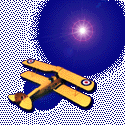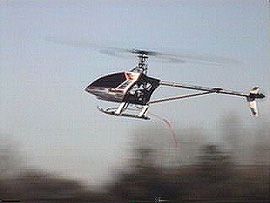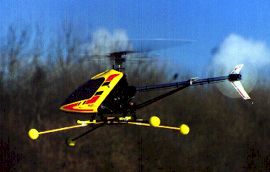

| Part 1 - The Hover |
 This
first step into flying model helis is probably the hardest part to learn,
mainly because you have to do it yourself. Of course an instructor can hover
your model and show you the basic controls, he will make it look very easy
but at least you know that if he can do it, the model must be okay. On your
first attempt at hovering you might wonder what you have got yourself into
as it seems almost impossible, don't worry, its like riding a bike and once
you can hover there is no going back.
This
first step into flying model helis is probably the hardest part to learn,
mainly because you have to do it yourself. Of course an instructor can hover
your model and show you the basic controls, he will make it look very easy
but at least you know that if he can do it, the model must be okay. On your
first attempt at hovering you might wonder what you have got yourself into
as it seems almost impossible, don't worry, its like riding a bike and once
you can hover there is no going back.You will need to fit a training under carriage, there are two types, crossed sticks with balls on the end or crossed sticks with a standard hula-hoop attached, either type is okay and they are usually fitted using cable ties.
Whatever radio you use make sure you have the best gyro you can afford as this will make control of the tail a lot easier. If you can get your hands on a good simulator it will help considerably, and at around £100 if you have a PC, it will be money well spent.
Try to choose a day with little or no wind and make sure you keep the model pointing into wind as this will help to keep the tail straight, all you are trying to do at this stage is to keep the model hovering on the spot at about 1 to 6 inches (25mm to 150mm) high, if it gets any higher, lower the throttle, land and try again. Just keep practising for as long as it takes, it will probably take several visits to the flying field to perfect the tail in hover.
 So
you can hover tail in and land fairly smoothly. Do not remove your training
under carriage; it will still be useful for the next step, which is hovering
side on. You can do this by hovering diagonally and gradually turning the
model side on as you progress, make sure you practise on both sides of the
model, it is very easy to get handed and once you have got the habit of
hovering only your favoured side it is hard to get out of.
So
you can hover tail in and land fairly smoothly. Do not remove your training
under carriage; it will still be useful for the next step, which is hovering
side on. You can do this by hovering diagonally and gradually turning the
model side on as you progress, make sure you practise on both sides of the
model, it is very easy to get handed and once you have got the habit of
hovering only your favoured side it is hard to get out of.All the above will take many hours of practise to perfect so take your time and don't remove your training under carriage until you feel you are ready to do so, you may want to move directly on to learning the nose in hover while you have it on, or you can leave nose in hovering until you can fly circuits when you can gradually fly the model towards yourself until you can stop and hover, which way you do this is up to you as I have seen it done both ways.
Remember,
the most important things you will need to become an RC Heli pilot are
patience and determination.
In Part 2 we will move on to flying circuits.
This page has been contributed by Jeff
Barrington
Web Site:
Newton Abbot Heli Club